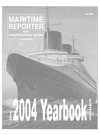
Security and Safety: Questions & Answers
MR recently sought some safety insights from Jim Ligotti is Vice President, Maritime Solutions, Ingersoll-Rand Security and Safety Solutions, Ingersoll- Rand Company Limited (IR).
Q: What does ISPS mean for ports and vessels?
A: All of the more than 300 coastal and interwaterway ports in the U.S., and the thousands of vessels that dock at them each year, were required to define their security plans by December 31, 2003.
Other "contracting" countries of the IMO were required to fulfill similar requirements.
Once the security plans are established, the ISPS requires that all port and vessels implement the necessary security measures outlined in the plan by July 1, 2004. Because of the ISPS, maritime facilities will have to make significant, unprecedented changes in their security and safety operations.
Q: What makes maritime security applications challenging?
A: In the complex world of maritime trade, hundreds or even thousands of crew members, drivers, maintenance workers, administrators and longshoremen, employed by unaffiliated companies and agencies, work together to move goods in and out of a port. A security system that relies on paper and people to track, manage and monitor vulnerable assets is simply unreliable and inefficient when used in such a demanding environment. Unfortunately, for most ports today, conventional methods continue to act as the backbone for securing people and assets.
Q: What are the basic principles involved with IR's approach to security and safety?
A: The primary goal of Ingersoll-Rand's approach is to integrate the security and safety requirements for every element of, and activity that takes place, at a maritime facility. The basic elements are categorized as people, openings, and assets. For example, a ship's "openings" include the engine control room, electrical control/equipment room, cargo storage area, bridge, and steering gear room.
A port's "people" include longshoremen, crew, administrators, maintenance workers, and truck drivers. Assets for both a port and vessel may include the vessels themselves, as well as equipment, vehicles, containers and cargo.
Q: How are the people, openings and assets integrated?
A: Ingersoll-Rand's methodology integrates people, openings and assets together through a connected information- technology infrastructure based on an expandable, open information technology (IT) architecture. Data is generated through the power of electronics — access cards with electronic codes or biometric identifiers replace or supplement paper forms of I.D., reducing significantly the number of security personnel required for security screening.
For more information Circle 35 on Reader Service Card
Other stories from June 2004 issue
Content
- New Joint Venture Tanker Company Sets Sail page: 9
- Crowley Refloats Stranded Passenger Ferry page: 10
- A Tradition Carried On page: 10
- EC: Spanish Shipyards Owe €308.3M page: 11
- Uljanik Delivers for Grimaldi-Napoli page: 12
- Washburn & Doughty delivers Independent page: 13
- Bollinger Repowers, Modifies 40-Year-Old Tug page: 14
- ACBL Announces Sweeping Changes page: 18
- Ocean Policy Study: Shortchanging Water Transport? page: 21
- Damen Delivers the Patrol Boat Valiant page: 25
- IZAR Christens LNG Ship page: 25
- Challenges facing IMO page: 26
- Flood Attracted to Water page: 30
- The Containership Market: Full Steam Ahead? page: 32
- Will Oil Continue Heading Up? page: 34
- Floating Production: The $8 Billion Market page: 36
- LNG Fleet Needs to Triple by 2020 page: 38
- New Free Fall Lifeboat Carries More People page: 41
- Wartsila to Power New DE Tanker page: 41
- Ice Tech: The Northern Promise page: 42
- New Era for Gas Engines page: 42
- Emulsion Breaking Bilge Water Cleaning System page: 44
- Balancing Security Safety and Commerce page: 46
- When the Clock Strikes Midnight page: 50
- The Layered Approach from a One-Stop-Shop page: 54
- JHOC: Eyes Wide Open page: 58
- The Posse Comitatus Act of 1878 page: 61
- Jacksonville Selects ObjectVideo's Solution page: 63
- Ship@Sight SSAS page: 63
- The Midas Touch page: 64
- Security and Safety: Questions & Answers page: 69
- Storm Warnings Raised over Readiness Concerns page: 70
- MACC 2004: Multi-Agency Craft Conference set for June 15-17 page: 76

